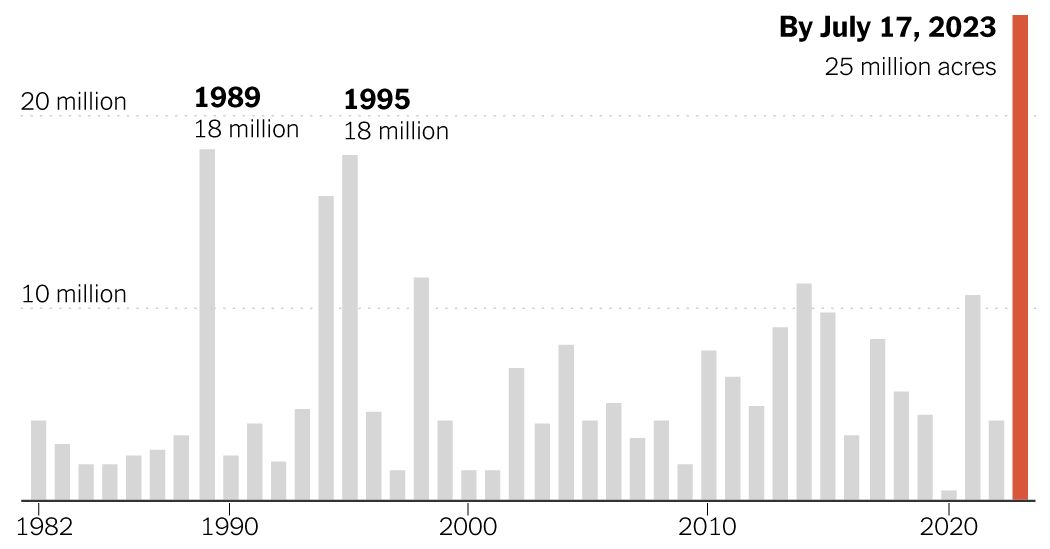How Canada’s Record Wildfires Got So Bad, So Fast
How Canada’s Record Wildfires Got So Bad, So Fast
Wildfires in Canada have burned a staggering 25 million acres so far this year, an area roughly the size of Kentucky. With more than a month of peak fire season left to go, 2023 has already eclipsed Canada’s previous annual record from 1989, when over 18 million acres were scorched. And the country’s worst wildfire season on record continues to rage.
Acres Burned by Wildfires in Canada By July 17, 2023 25.2 million acres 1989 20 million 1995 18.3 million 18.0 million 10 million 1982 1990 2000 2010 2020 By July 17, 2023 25.2 million acres 20 million acres 1989 1995 18.3 18.0 10 million 1982 1990 2000 2010 2020 Source: Canadian Interagency Forest Fire Centre Total acres burned from January through December each year. By Nadja Popovich
Hot, dry conditions have fueled widespread wildfires, mostly in Canada’s boreal forests, since the spring, with some of the largest blazes burning in Northwest Canada and Quebec. The fires have forced more than 120,000 people to evacuate their homes, stretched firefighting resources thin and repeatedly darkened the skies and polluted the air for millions of people across North America.
“What is kind of extraordinary this year is that the fire season started early and in multiple areas at the same time,” said Jennifer Kamau, a spokeswoman for the Canadian Interagency Forest Fire Center.
In a more typical season, Ms. Kamau said, “fires would flare up in one part of the country, then die down and then start in another area,” which allows fire crews to tackle one region at a time. But this year, she said, “demand in every province and territory is high,” nearly coast-to-coast.
International fire crews from across the globe, including more than 1,800 firefighters and support staff from the United States, have been mobilized to help battle the flames since May, but the size and ferocity of the blazes has often hampered their efforts even as many of the largest, most remote fires have been left to burn. Over the past week, two Canadian firefighters were killed on duty just days apart.
Canada wildfires Burned Hot spots Source: Canadian Wildland Fire Information System By Martín González Gómez and Madison Dong
High temperatures in the spring helped the fire season get off to an intense early start. A heat wave baked British Columbia and Alberta in mid-May, exacerbating several early wildfires. In early June, multiple fires broke out in Quebec amid record heat and rapidly intensified. By the end of the month, June was recorded as the planet’s hottest month ever and some of the world’s most anomalous temperatures were found in Northern Canada.
“The recipe for a wildfire is simple,” said Mike Flannigan, a professor who studies wildland fires at Thompson Rivers University in Kamloops, British Columbia. “You need three ingredients: First, vegetation. We call it fuel. Second: ignition, which in Canada is people and lightning. And, third: hot, dry, windy weather.”
Those ingredients came together over and over again this year across much of the country, he said, resulting in a fire season that stands “head and shoulders above any other year.”
By early June this year, Canadian wildfires had already burned as many acres as they usually do over an entire season.
An Early and Intense Fire Season Wildfire hot spots detected by satellite 300,000 cumulative detections 2023 200,000 All other years since 2003 100,000 0 days since May 1 50 days 100 days 150 days 300,000 cumulative detections 2023 200,000 All other years since 2003 100,000 0 days since May 1 50 days 100 days 150 days Source: Natural Resources Canada Hot spots detections from the beginning of May through the end of September. Data for this year runs through July 17. By Nadja Popovich
The hot, dry, windy conditions that make it more likely for fires to take hold are becoming more common in many parts of the world as the planet heats from the burning of fossil fuels and other human activities. Canada has, on average, warmed twice as fast as the rest of the world in recent years, largely because of a loss of snow and sea ice.
Studies directly linking climate change to this year’s wildfires have not yet been carried out, but the 2023 fire season is in line with scientists’ understanding of how global warming is affecting wildfires.
“Fire season is getting longer, we’re seeing more frequent fire-conducive weather, the conditions are getting more severe, the vegetation is getting drier and more primed to burn if there are ignitions,” said Yan Boulanger, a research scientist in forest ecology at the Laurentian Forestry Centre in Quebec. “These are very significant trends we are seeing across large swaths of Canada.”
That doesn’t mean that quieter wildfire years, like last year, are no longer possible, Dr. Flanningan said, but a warmer world makes large, explosive wildfires more likely than they were in the past.
This year’s hot, dry conditions have contributed to extreme fire behavior, too, experts said. More than 100 times over the past three months, Canadian wildfires have grown sufficiently large and powerful to produce their own weather, kicking up giant thunderclouds known as pyrocumulonibus, and injecting smoke high into the atmosphere. These events can help transport smoke over very long distances.
The previous most active year for such extreme fire weather in Canada was 2021, which had fewer than half as many pyroCbs, as they are more commonly called, over the entire season. The Times revealed how one such fire cloud formed from the Dixie fire in California that same year.
Forecasts for the rest of the summer suggest that higher-than-normal fire activity is likely to continue across much of Canada, which could mean more heat, more fires and more smoke ahead.
Source: The New York Times


